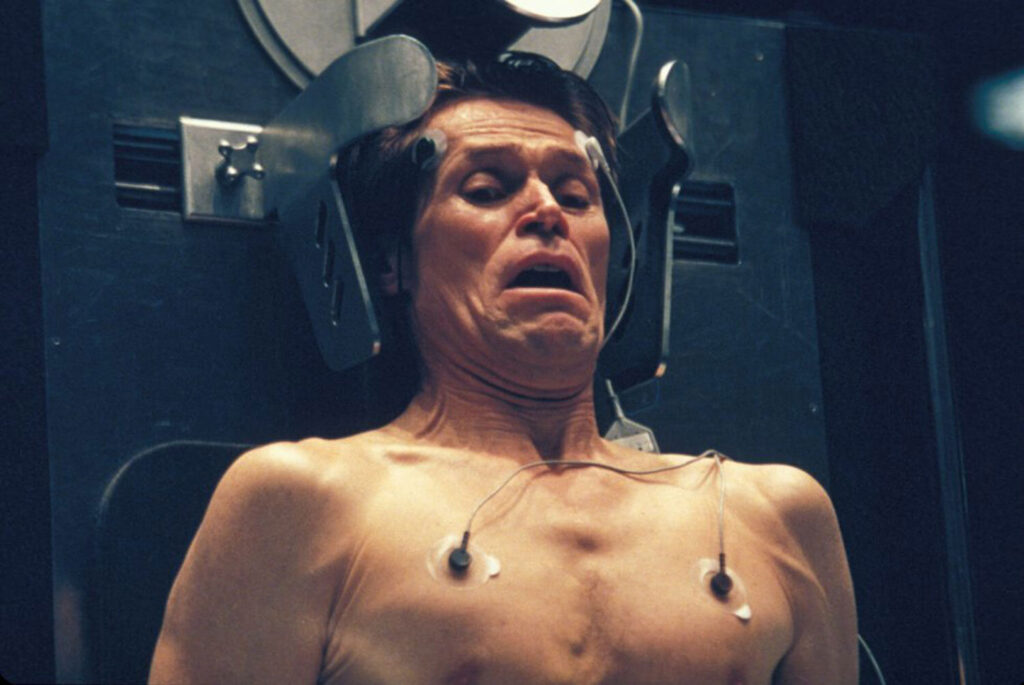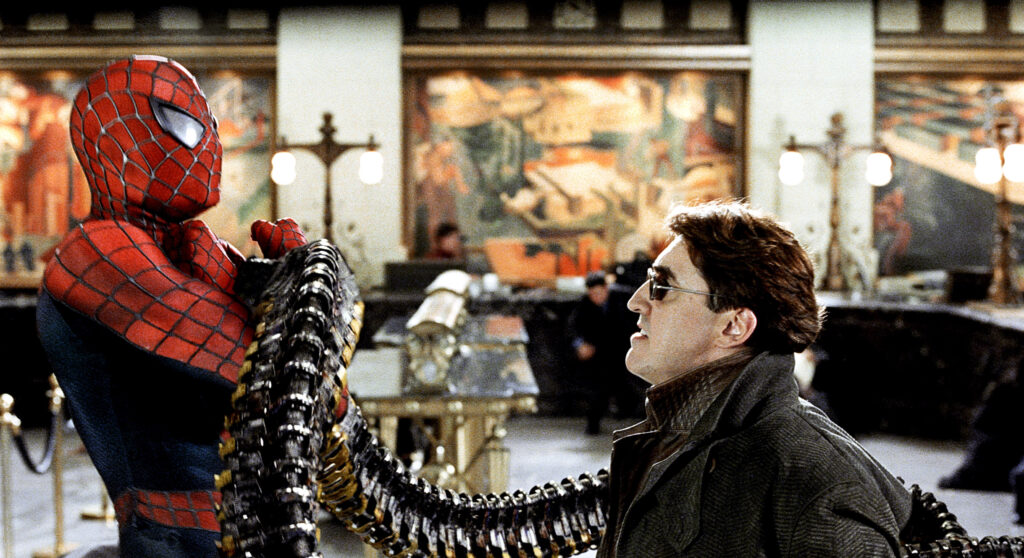Sam Raimi’s Wicked Horror Spin on ‘Spider-Man 1 & 2’

One thing you can count on with Sam Raimi: he’ll always bring the horror no matter the budget or the genre, and we’ll forever love him for that. He absolutely brought the horror in his spin on the Spider-Man franchise.
Spider-Man: No Way Home is out and riding high on the multiverse phase of the MCU, though the main draw is clearly nostalgia. Green Goblin and Doctor Octopus return from Raimi’s Spider-Man 1 & 2 to wreak havoc on Tom Holland’s Peter Parker. And while it’s thrilling to see Willem Dafoe and Alfred Molina reprise their iconic roles, I found myself nostalgic for Raimi’s handle and verve with the characters. Nearly 20 years ago, Raimi did the whole comic book thing one better. He made Green Goblin and Doc Ock scary as hell.
Their villain names alone should’ve made this impossible to achieve, yet Raimi made it look easy. There are bits in Spider-Man 1 & 2 that legit frightened me as a kid. Like Green Goblin’s borderline demonic transformation. Or Doc Ock’s terrifying hospital escape. These were among the first scares I recall having in the theater, in a superhero movie of all things. Us kids were there to see the web crawler come to life on screen. On top of that, Raimi gave us the jump-scare ride of our lives. This campy, in-your-face horror is not only a crucial part of what made Green Goblin and Doc Ock so memorable as on-screen villains. It’s also integral to Raimi’s visual style since the days of Evil Dead and Darkman.
Related: 5 New Classic Horror Movies PRODUCED By Sam Raimi
The best heroes need the best villains. Fortunately (or unfortunately) for Spider-Man, Green Goblin and Doc Ock are larger than life. They’re practically movie monster-sized the way Raimi shoots them. Norman Osborn is the head of Oscorp, while Otto Octavius is the pioneer in nuclear fusion. Both men are formidable by way of reputation. They’re also charming, charismatic, and quite fatherly to a dotting young Peter Parker.

Brilliance and ambition are their superpowers long before the experiment goes wrong (or right?). Norman and Otto are the comic book update of the cautionary mad scientist tale. They start out with the best intentions, but the things they create—which happen to be the biggest red flags for all mankind—wind up consuming them.
We meet Norman Osborn on the precipice of his duality. He’s a comforting and soft-spoken patriarch. But in the throes of Oscorp and an executive board breathing down his neck, he’s quickly losing patience. So, Norman throws his confidence behind his super-soldier serum. His colleague Dr. Stromm, however, provides a warning. Norman is then told he needs to make an overnight breakthrough or he’s out. So he does the experiment on himself.
This is where Raimi injects his horror craft—and the part that freaked me out in the theater at 10 years old. Norman goes into the chamber, enveloped in smoke, and his eyes roll up his skull as he tremors violently. The only special effect in the scene is the smoke in the chamber that’s color-corrected green in post-production. Otherwise, that’s Dafoe doing all of that with his body on camera. Raimi pulls a wicked snap zoom the moment Norman comes to and grabs his partner Dr. Stromm by the neck. I’ve never hit the back of my seat so fiercely.
Related: Benedict Cumberbatch Praises DOCTOR STRANGE 2 Director Sam Raimi
Raimi is perfectly at home here mixing comic book and horror elements like a mad genius himself. He heightens Norman’s scenes with Dutch angles to illustrate the bizarreness of his mental state. There’s something slightly off-kilter with him following the accident. Dr. Stromm is his voice of reason and now he’s gone. Now, Norman is haunted by the Goblin’s maniacal laughter. But really, it’s just him alone in his gothic mansion, cornered by masks all-around.
Raimi comes up with a simple but diabolical solution to convey Norman’s split personality: the mirror conversation. Norman’s staring in the mirror and it’s his alter-ego staring back. Sometimes Raimi cuts between Norman and Goblin in reverse shots. Other times, Raimi blurs the distinction between the two personalities in the same frame. They’re trapped in one body, but one is subservient and the other is running the show.

Norman’s descent borrows from the literary canon of Dr. Jekyll and Mr. Hyde. Jekyll. The serum in the story ceases to keep Hyde at bay and soon transforms into his alter ego involuntarily. He’s developed dual (and dueling) psyches, becoming unstable and prone to wild mood swings.
Related: A Spider-Horror Story Fit for Sam Raimi
And yet there is something else familiar here. The character of Green Goblin, in a way, is Raimi’s sly spiritual sequel to his little-loved Darkman – his first attempt at a comic book movie through an original concept. Like Norman, Dr. Westlake is a man with the intention to do good in the world, working to develop a type of synthetic skin to help burn victims recover. When Westlake is caught in a political power grab, he becomes a burn victim himself and is left permanently disfigured. He gains superpowers in the process of being treated, but becomes increasingly unstable in his pursuit of vengeance. He has an infamous meltdown at a carnival over a mere stuffed elephant that reveals his true, grotesque self.
Norman reaches a point where he cannot keep the Goblin at bay. Any moments of genuine concern on Norman’s part, the Goblin exploits as a way to lash out violently. Like when he discovers Peter Parker’s own alter-ego as Spider-Man, or his son Harry telling him that MJ broke up with him because she’s in love with Peter. Norman hears, and the Goblin schemes.
The Goblin persona no longer needs the exo-suit and glider to make himself known. Raimi eventually does away with the mirror motif. It’s all in Norman’s head, a conversation played out literally for the audience, but the line between Norman and Goblin is barely perceivable by the end. Whether he flares up at a board meeting or at Thanksgiving dinner, you don’t know if the Goblin has allowed Norman to be his true self, or if Norman is lost in the Goblin’s psychotic rage.
Related: Sam Raimi Used a Shot From Lucio Fulci’s The Beyond in Spider-Man
The last we truly see of Norman is in his final breath where he reminds us there was a father in there too: “Don’t tell Harry.” The Goblin is gone, and it takes Norman with him.
If Green Goblin is Dr. Jekyll and Mr. Hyde, then Doc Ock is Victor Frankenstein. The ungodly creation happens to be his A.I.-driven mechanical arms. Otto uses metal tentacles to handle hazardous materials. But like Norman, Otto is tampering with nature, meddling with things he cannot control. He introduces his “assistants” as he calls them so matter-of-factly like he hasn’t created something morally questionable that might turn on him. The neurochip meant to be a buffer between Otto and the intelligence of the arms is so minuscule compared to the larger creation that it’s destined to break the moment he points to it. Amidst the mechanical monstrosity, it’s Otto who looks like the appendage, not the arms.
Through Doc Ock, Raimi unleashes his Evil Dead-style flair. Throughout Spider-Man 2, if Raimi can whip the camera to a closeup of somebody screaming in terror, he will. The hospital scene is Doc Ock’s “birth” so to speak, with Raimi giving the villain his proper spotlight intro.

Danny Elfman’s score halts entirely throughout the sequence. Doc Ock’s arms come to violent life, set to the sounds of high-pitched screams and nails clamoring on the linoleum floor. Raimi, in a cheeky way, pulls off a mini-cabin run like the demonic entity that chased Bruce Campbell through the woods. Lo and behold, there’s a mini chainsaw in the sequence, too. Though things don’t end as triumphantly for the orderly as it once did for Ash. Otto wakes up screaming like Frankenstein’s Creature, except he is creator and creation fused together.
Related: Don’t Breathe – Fede Alvarez, Rodo Sayagues and Sam Raimi Interview
Villains tend to keep plots to themselves. But Raimi’s villains aren’t afraid of monologues or soliloquy. They lean into the theatrical and pontificate aloud like tragic figures. Otto talks to the mechanical arms like devils on his shoulders. But there isn’t a two-sided conversation like with Norman. We only hear Otto’s affirmation. He lost his wife Rosalie, the only angel who tempered him and made him lead with love. The arms appeal to him at his worst, driving him to madness and self-obsession. In the beginning, Otto strives for fusion energy to solve the Earth’s renewable energy crisis. Doc Ock rebuilds the reactor because he harnessed the power of the sun momentarily, blinded by its magnificence. Then Spider-Man got in the way.
If Green Goblin was Spider-Man’s “equal,” then Doc Ock reigns like a true movie monster. Raimi shoots his entrances like the T. Rex in Jurassic Park or Godzilla rising from below, the whole environment trembling with each stomp of the mechanical arms. Doc Ock even treats innocent lives like things beneath him; he tosses Aunt May off a building like an afterthought and lobs pedestrians at Spider-Man like Goblin throwing pumpkin bombs. He’s more than willing to harm and sacrifice others for his own gain, whether it’s a train full of people or Peter Parker in his path.
Related: Kids Hoping for Spider-Man Superpowers Bitten by Black Widow–On Purpose
This, in the end, is Doc Ock’s and Green Goblin’s downfall. The tunnel vision of their ambition robs them of their humanity. Their villain transformation is complete, shockingly and tragically – a far cry from the starry-eyed scientists we first met. Unlike Green Goblin, however, Doc Ock is redeemed at the end. He sees what he’s become. Otto says “we” following the fusion accident. Only at the end, he says, “I”. Like Frankenstein’s Creature, he accepts responsibility and condemns himself into the sea.
Dr. Jekyll was trying to suppress man’s inherently evil nature. Victor Frankenstein sought to cheat death out of grief. Norman Osborn and Otto Octavius’ intentions start out pure and noble. But by the end, they become vengeful, monstrous and inhuman.
Green Goblin and Doc Ock mightily bring the nostalgia in Spider-Man: No Way Home. Dafoe and Molina are pulled from one context and dropped into another. It’s a spectacle in and of itself to see them interact with each other and face a new Spider-Man. They fulfill their function in the MCU nearly two decades later—Dafoe especially bringing the menace and themes of destiny home for Holland’s Peter Parker. But with Raimi at the helm, Green Goblin and Doc Ock were tragic-horror figures. They got to be larger than life; they got to be intense, campy, frightening, and straight-up rule as the big baddies.
Spider-Man: No Way Home more than anything made me nostalgic for the Raimi-verse. He subtly gave us a Darkman sequel and dropped a mini–Evil Dead movie. Who gets away with stuff like that at the big-budget studio level? Sam Raimi, that’s who.
Categorized:Editorials News

